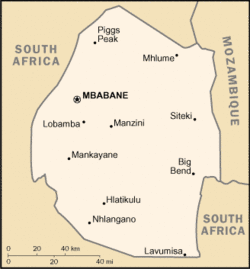Welcome to the Virtual Education Wiki ~ Open Education Wiki
Eswatini
Partners situated in Swaziland
None.
Swaziland in a nutshell
(sourced from http://en.wikipedia.org/wiki/Swaziland)
Swaziland, the Kingdom of Swaziland (Umbuso weSwatini), sometimes called Ngwane, is a landlocked country in Southern Africa, bordered to the north, south, and west by South Africa, and to the east by Mozambique.

The nation, as well as its people, are named after the 19th century king Mswati II.
Its population is 1.18 million.
Its capital is Lobamba (royal capital) and Mbabane (administrative capital and the largest city).
Swaziland's economy is dominated by the service industry, manufacturing and agriculture. Some 75% of the population are employed in subsistence farming, and 60% of the population live on less than US$1.25 per day.
Swaziland's main trading partner is South Africa, and its currency is pegged to the South African rand.
Swaziland's economic growth and societal integrity has been highly endangered by an ongoing HIV epidemic.
Education in Swaziland
Education in Swaziland is now free at primary level mainly 1st and 2nd grades and also free for orphaned and vulnerable children but not compulsory. In 1996, the net primary school enrollment rate was 90.8%, with gender parity at the primary level. In 1998, 80.5% of children reached grade five. (1) Primary school attendance rates were unavailable for Swaziland as of 2001. In 1996, 91.3 percent of the teachers were certified to teach according to national standards, and the pupil to teacher ratio was 33:9. (2)
Swaziland education system
Pre-Primary education The Ministry of Education’s policy has moved away from Pre-School Education that caters for children between the ages 3 to 6 in order to also incorporate ages 0 to 3. However, the Ministry has no formal control over this very early level of education because it has not yet been fully integrated into the formal education structure.
Basic education Swaziland adopted a ten-year basic education programme as part of the Southern Africa Development Community (SADC) Protocol on Education. Seven years of primary education are followed by three years of lower secondary education. This system faces several challenges that include ensuring the availability of schools and teachers, and the provision of teacher salaries.
Secondary education As in many countries in sub-Saharan Africa, Swaziland’s school system allows only a small proportion of students access to secondary school. The bulk of the students drop out at earlier levels. The Government is exploring ways to ensure that graduates at this level possess the skills and knowledge to participate effectively in society. This has led to the development of a prevocational pilot project that aims to give children practical and entrepreneurial skills.
Non-formal education Non-formal education is currently in the hands of non-governmental organizations (NGOs) and parastatal bodies. They mainly address the need for adult literacy and numeracy programmes. (3)
Higher education
Universities in Swaziland
The University of Swaziland provides higher education (1) and seems to be the only one. See http://www.uniswa.sz/
Polytechnics in Swaziland
Colleges in Swaziland
Education reform
Schools
Swaziland’s main priority at Independence in 1968 was to expand its school system. Over the following 20 years there was a major increase in resources made available to all levels of education, and a systematic movement towards the achievement of Universal Primary Education (UPE) in 1985. In recent years the country has been struggling to maintain UPE because of difficulties associated with financial constraints, the HIV/AIDS pandemic, and poverty - which is beginning to manifest itself in the rural areas of the country. (3)
Post-secondary
Administration and finance
Schools
The education system is still very centralised, with all power and authority located at the national level. There is minimal delegation, and the main task of the District Education Officers is to focus efforts on the implementation of national policies. The National Ministry of Education manages the curriculum, assessment procedures, and recruitment of teachers. However it should be noted that this is carried out in association with local communities and civil society. (3) For example, the Ministry of Education pays teacher salaries, while student fees and money raised from the community pay for costs such as building upkeep and teacher housing. (2) Financial planning is controlled by the Ministry of Planning and Development and the Ministry of Finance. That is, the Ministry of Education’s financial operations are decided and monitored elsewhere - a situation that offers many challenges for the Ministry of Education. (3)
Post-secondary
Quality assurance
Schools
The National Ministry of Education manages the curriculum and assessment procedures.
Post-secondary
Information society
ICT in education initiatives
Virtual initiatives in schools
Virtual initiatives in post-secondary education
The University of Swaziland has an Institute of Distance Education which has in October 2009 produced Issue 1 of an informative Newsletter - http://www.uniswa.sz/academic/distlearn/newsletter.pdf
The Institute will offer three new programmes:
- Certificate in Portuguese
- Bachelor of Education degree in Primary Education
- Bachelor of Education degree in Secondary Education
These are done in collaboration with the Eduardo Mondlane University in Maputo (Portuguese programme) - it is the oldest and largest university in Mozambique - and the staff of the University of Swaziland Faculty of Education (degrees in Education)
The Institute has also recently installed Moodle.
Lessons learnt
References
1. http://en.wikipedia.org/wiki/Swaziland#Education
2. http://en.wikipedia.org/wiki/Education_in_Swaziland
3. Southern and Eastern African consortium for monitoring educational quality http://www.sacmeq.org/education-swaziland.htm